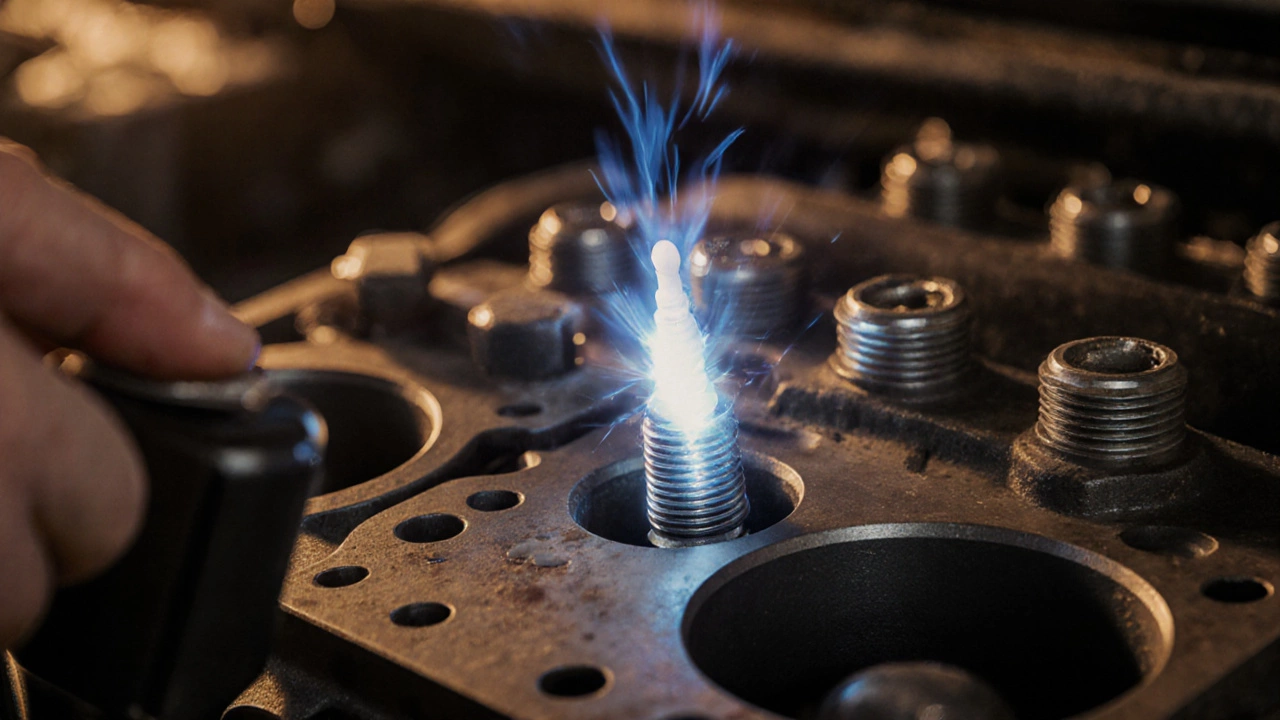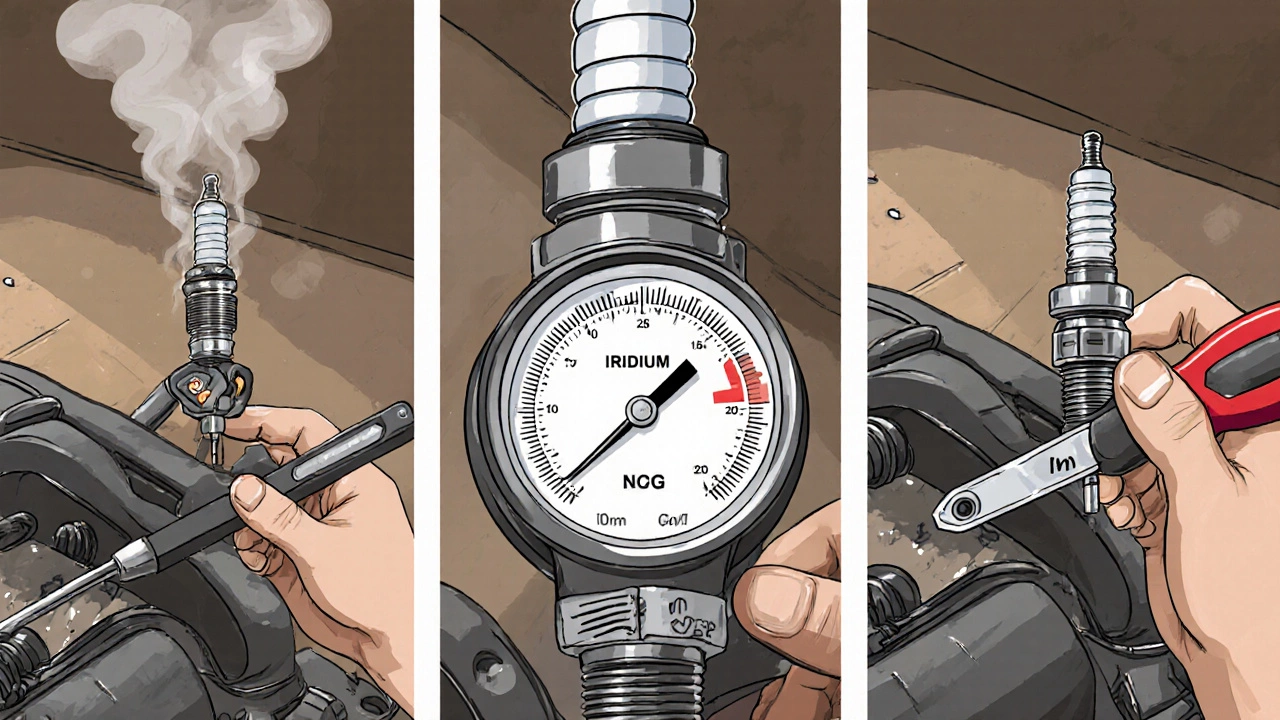 Oct, 13 2025
Oct, 13 2025
Spark Plug Health Estimator
Calculate Your Spark Plug Replacement Needs
Estimate when your spark plugs should be replaced and how much fuel you might be wasting due to worn plugs.
Results will appear here...
Quick Takeaways
- Spark plugs create the spark that ignites the fuel‑air mixture throughout every engine cycle, not only at start‑up.
- Their work is tied to the entire ignition system, including coils, ECU and fuel delivery.
- Worn or fouled plugs cause misfires, reduced power, higher fuel consumption and louder emissions.
- Typical replacement intervals range from 30,000km to 100,000km depending on plug type and driving habits.
- Regular visual checks and monitoring engine codes keep the plugs doing their job.
When you turn the key, the first thing you notice is the engine roaring to life. Most car owners assume the spark plug’s only job is to fire up the motor, but that’s a big oversimplification. spark plugs keep the engine running smoothly long after the starter has stopped turning the crankshaft.
Spark plug is a small electromechanical device that delivers an electric spark across a gap inside the combustion chamber. It sits in the cylinder head, threaded into a metal shell that seals against the high‑pressure environment. By igniting the compressed fuel‑air mixture at precisely the right moment, the plug initiates the power stroke that drives the pistons.
How a Spark Plug Works During Starting
The starter motor spins the engine fast enough to compress air and fuel. At the same time, the ignition system sends a high‑voltage pulse to the plug. This initial spark is strong because the engine is cold and the fuel mixture is richer than normal. The goal is simply to get the first few cycles firing so the engine can pick up speed and the coolant warms up.
What Happens Once the Engine Is Running
After the engine reaches idle speed, the role of the plug doesn’t change - it still has to fire every combustion cycle. The difference is that the engine’s operating temperature stabilises, the fuel‑air ratio leans out, and the ECU ( engine control unit a computer that manages ignition timing, fuel delivery and emissions controls ) tweaks the spark timing for optimum efficiency.
Every cylinder fires once per two crankshaft revolutions in a four‑stroke engine. That means a four‑cylinder engine with a single‑coil‑per‑cylinder system receives four sparks per engine cycle, not just the first few. If a plug fails to spark at the right moment, that cylinder will misfire, causing a loss of power and rough idle.
Why Spark Plugs Matter for Engine Performance
Good spark plugs are the unsung heroes of:
- engine performance the ability of the engine to produce power smoothly across the rev range
- fuel efficiency how much fuel the engine consumes to deliver a given amount of power
- emissions control the reduction of unburned hydrocarbons, carbon monoxide and nitrogen oxides
A weak spark or an improperly gapped electrode can cause incomplete combustion. The result is a noticeable dip in acceleration, higher fuel consumption and a smoky exhaust. Modern engines rely on precise spark timing to run at leaner mixtures, so plug health directly influences EPA compliance and warranty durability.
Common Symptoms of Failing Spark Plugs
Even if the car starts fine, you might be living with plug problems. Look out for these clues:
- Rough idle - the engine shakes at low speeds.
- Engine hesitation or stumble when you press the accelerator.
- Reduced power, especially noticeable on uphill climbs.
- Increased fuel gauge movement after short trips.
- Knocking or pinging sounds from the combustion chamber.
- Check‑engine light with codes P0300‑P0304 (random or cylinder‑specific misfire).
When you see any of these, it’s time to inspect the plugs. A simple visual check can reveal carbon fouling, oil deposits or worn electrodes.
How Long Do Spark Plugs Last?
Plug lifespan depends on type, engine design and driving conditions:
- Copper core plugs - economical, but usually need replacement every 20,000-30,000km.
- Iridium plugs - premium material with a tiny center electrode, lasting 60,000-100,000km.
- Platinum plugs - sit between copper and iridium, lasting around 40,000-70,000km.
Harsh environments (dusty roads, frequent short trips, heavy towing) accelerate wear. Many manufacturers now recommend checking the plug gap at each service interval, even if the mileage limit hasn’t been reached.

Replacing Spark Plugs: Step‑by‑Step Guide
- Gather tools: socket wrench with spark‑plug socket, torque wrench, gap gauge, anti‑seize compound.
- Let the engine cool down completely - hot plugs can warp.
- Disconnect the ignition coil or plug wire for the cylinder you’ll work on.
- Remove the old plug using the socket, turning counter‑clockwise.
- Inspect the plug for fouling, wear or cracked insulator.
- Check the new plug’s gap with a gauge; adjust if the manufacturer specifies a range.
- Apply a thin layer of anti‑seize to the threads (avoid the tip) and hand‑tighten the plug.
- Use a torque wrench to tighten to the vehicle‑specified torque (usually 20‑30Nm).
- Reconnect the coil or wire, repeat for each cylinder.
- Start the engine and listen for a smooth idle; a slight pop is normal.
If you’re unsure about the correct torque or gap, the vehicle’s service manual (or a trusted online database) provides exact numbers. Forgetting the torque can either damage the threads or leave the plug loose, both of which lead to misfires.
Related Components That Influence Spark Plug Performance
While the plug is the star, a few teammates play vital supporting roles:
- ignition coil converts the battery’s low voltage into the high‑voltage pulse needed for a spark - a weak coil reduces spark energy.
- fuel injector delivers precise amounts of fuel into the combustion chamber - improper fuel‑air mix can make the spark look like the problem.
- distributor routes high‑voltage pulses to the correct cylinder in older ignition systems - timing errors can mimic plug wear.
When diagnosing an engine issue, consider these parts before swapping out plugs. A faulty coil can cause the same misfire codes even with brand‑new plugs.
Frequently Asked Questions
Do spark plugs affect fuel economy?
Yes. A proper spark ensures the fuel‑air mixture burns completely. Worn plugs can cause incomplete combustion, making the engine burn more fuel to maintain power.
Can I use the same spark plugs for all my cars?
No. Spark plugs are sized and heat‑rated for specific engines. Always check the vehicle’s service guide for the correct part number, thread size and heat range.
What is a ‘heat range’ and why does it matter?
Heat range describes how quickly a plug disperses heat from the tip. A plug that runs too hot can over‑heat and cause pre‑ignition; one that’s too cold may foul with deposits. Choosing the manufacturer‑recommended range keeps the engine in the sweet spot.
Is it okay to clean a fouled spark plug and reuse it?
Minor carbon buildup can be gently cleaned with a wire brush, but if the electrode is eroded, the tip is cracked, or the insulator is damaged, replacement is the safest option.
Why does the check‑engine light flash during a hard start?
A flashing light usually signals a severe misfire, often caused by a weak spark during cranking. The ECU shuts down fuel to protect the catalytic converter.